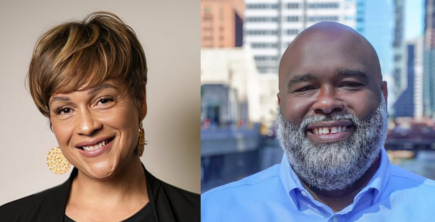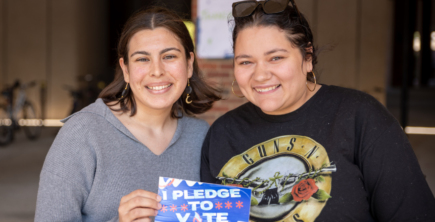
Tides Coaching Corner: Approaching Fundraising

Welcome to Coaching Corner, a new Q&A series in which our Tides staff members share insight and best practices from their work in the field, from relationship building to fundraising and beyond. In this first segment, we explore how Tides staff approach fundraising in client partnerships. Tides Advisors Charnelle Etti, Irini Neofotistos, and Sonya Watson, dive into frequently asked questions on fundraising and share how they have advised their clients.
Q: One common question is “A new donor agrees to a coffee meeting. Now what?”
Sonya: A donor or funder accepts your invitation to meet? This is great news! First thing—do your research. Most of the time, an in-person donation appeal indicates that the individual or foundation has the potential to be a major donor. Often times, program officers are looking for partners on the ground and/or organizations doing the work.
Q: What should clients do to prepare for a funding request?
Charnelle: I encourage my clients to consider the donor’s connection, ability, and interest in making a gift or awarding a grant. It’s helpful to determine any existing relationships or connections, then determine their financial ability to give. Perhaps most importantly, establish whether their philanthropic priorities align with your mission. When my clients have been intentional about identification and qualification, they are comfortable that they have ties with donors with enough capacity and mission alignment with their organization.
Sonya: Foundations often highlight the programs they’re supporting on their website. Looking at who they’ve funded in the past can give you insight into whether your work is a fit. Identifying other grantees who have experience with the funder can help you learn more and build rapport with peer organizations. The program officer’s bio page can also give you clues on how to connect them with your work.
Depending on your existing relationship with the individual, this research can take a variety of forms. If they have given to your organization in the past, you should consider your organization’s needs alongside the donor’s giving history to get a ballpark estimate of how much you should ask for. A great example: If they have volunteered with your nonprofit previously, determine which events and projects they have given their time to. Knowing what they feel passionate about will help you better tailor your ask.
By completing simple research before you start your appeal, you’ll be better off in the long run. Forming relationships with donors takes time, but the end result will be well worth the hours and patience.
Q: Assuming the donor is a good fit, what are the next steps to prepare for the ask?
Charnelle: Practice every single aspect of your ask, including various paths the conversation could take. Plan the structure of the conversation, how to transition to ask, what information you plan to share to support your ask. Most importantly, anticipate potential objections and how to address them. Being prepared for “I can’t afford the amount you are asking for” or “I care about [X issue area]. How does your organization differ from others I donate to?” is a great way to prepare, and will build confidence as you walk into the ask.
Sonya: There is no need to be nervous. You’re passionate about the work and you’re experienced in your issue area. Imagine how the potential donor fits into your work. The last thing you want is to go into a meeting with a donor and forget every point you were going to say. To help alleviate this fear, practice your pitch regularly!
I don’t recommend memorizing a speech or carrying note cards in your back pocket, you should review your pitch several times before making your official ask, but stick to your organization’s reasons for existence, including why the work is urgent, why you personally believe in it, and why supporting the work has to happen now. Then wrap around to how the potential donor fits into your work. Feel free to practice in front of a mirror or with colleagues to make notes of your body language and any nervous gestures. While you can hope for a resounding “Yes!” from a donor when you ask them for a donation, you have to be ready for a range of responses. This is where storytelling helps you build the relationship. Why is this work is important to you? Make it personal.
Q: Why do you think so many people get nervous about making asks? What would you say is the scariest part?
Charnelle: I think it comes down to the fear of rejection. When making the ask, thousands of potential scenarios come into play. Our clients wonder what happens if they are asked a question they can’t answer or if a donor is unwilling to give—what happens next? When it comes to fundraising, managing and eventually overcoming the mental obstacle of fear of rejection is a critical part of success. It takes time, but is possible.
Q: What can clients do to overcome the fear of making the ask?
Charnelle: To overcome fear and grow confidence, I always tell my clients to do their homework. Similar to preparing for an exam, I would advise studying up on both your mission and your donor. Studying is critical to feeling ready to take an exam and the same preparation is necessary before making an ask. Learn about your donors’ background, professional life, hobbies, and interests. This gives you a strong foundation to quickly build a relationship and start connecting your donor’s passions and background to your cause.
Q: Many people are worried about sounding pestering/bothersome/frantic. What’s your advice on how to strike the right tone?
Sonya: Being genuine, but direct, shows that you are interested in a donor, or a donor contributing to your cause. It also demonstrates that you are invested in the cause as well. Share a short, but heartfelt story of why you’re invested in the work. Additionally, once you ask for a gift, don’t be vague. State a specific amount that you can back up with information gathered during your research stage. Directly ask for an amount and remember to be flexible and let the donor ask questions. Keeping the dialogue open will help ensure that you receive the donation you’re asking for.
Finally, let the donor specifically know what the money would or could go toward. It’s wise to let them know how you generally plan on allocating the money. This is a great opportunity to share material, such as flyers, photos, upcoming event information, etc. There isn’t a need to present a formal proposal. This is something a program officer will invite you to do and you can submit it by email in a more formal way.
Q: People frequently ask about who the appropriate person to make the ask is. Is the best person the executive director, a development professional, an advisory board member, or some combination?
Charnelle: This is a great question—one I hear often. The outcome of the research and qualifying stage will usually give you a great sense of who the right person to make the ask is and who else should accompany them. For example, if an advisory board member holds a relationship with a donor, they should be present. Depending on the kind of ask and the nature of the organization, consider incorporating the direct beneficiaries or their stories in the ask. Ultimately, what makes the ask successful is identifying donor differences, which allow you to better tailor your message and strategy.
Q: What should I do if I’m rejected?
Sonya: Don’t be deflated—a “no” today could be a “yes” tomorrow! Instead, be prepared for people to say no, maybe, etc. Don’t give up! Instead, take a step back and readjust your pitch. As you tweak your talking points, be prepared to practice and get back on the horse to ask again. I want to stress—don’t pester a potential donor until they’re annoyed. If they appear to be uninterested in giving money, this is a perfect opportunity to invite them to support in other ways, such as volunteering or attending an event.
Q: What happens if my meeting goes well and I receive a donation?
Sonya: This is always exciting! When you receive a donation, make sure that you follow up with donors and thank them. You can consider:
- Sending a personalized thank you letter after the initial meeting and once the donation has been made.
- Highlight your donors in your annual report or somewhere on your website (unless they prefer to remain anonymous).
- Staying in touch by sharing invitations to future events.
In highlighting your donors’ generosity, you are deepening your relationship with them, which can lead to more donations for your organization. Appreciation goes a long way!
Q: How would you respond to a client that comes to you and says, “My donor fell through. Now what?”
Irini: There can be a lot of emotions hidden in those two simple sentences. The first thing I would do is acknowledge the disappointment. As a former grant seeker, program director, and grantmaker, I know there is a lot to unpack here. Having these experiences allow me to utilize those roles in order to respond effectively. It allows me to understand the moment and lead with empathy. Let’s look at each role separately:
Program directors have a big responsibility. Others look to them to build confidence in their organizational missions, programmatic strategies, and operational plans. We often forget that there are lots of people involved in the proposal planning process, so when a grant is awarded, work can immediately begin towards meeting the promised deliverables. A proposal rejection often means that those engaged—existing and potential new staff, community members, other funders, vendors, key partners—are also impacted by the work not moving forward as expected.
I would likely want more context about the funder and whether it is an existing or new relationship. Our funders are wonderful stakeholders in furthering our work. While it may seem counter-intuitive, I would suggest that the project director reach out to their contact at the foundation to learn more about the selection process and request feedback. Program officers can often share information about peer funders who may be interested in funding the work and potentially offer an introduction.
As a grantmaker, I was a fierce advocate for potential grantees doing good work and made the case for funding to a broad range of individuals. To do this, I focused on storytelling that highlighted my foundation’s mission, provided clear financial analysis, and identified partners who made key contributions and filled gaps in the field. I connected deeply with personal testimonials and highlights about how the work affected families, communities, and regions. I was often just as heartbroken by a grant that could not be made. I welcomed the conversation around how to approach future grant opportunities. It is a two-way street!
Q: What are some questions you would recommend asking the program officer?
Irini: I would recommend asking some of the following questions:
- What could I have done differently in the proposal or submission process?
- Was there a way I could have supported you to make the case for this grant?
- Do you suggest reapplying?
- Who are other funders that grant in this area? Would you be willing to provide an introduction?
Q: What are some practical ways you respond to operational questions that arise as a result?
Irini: As an advisor, I think through what else is affected due to this funding gap. Often, we talk with our clients about ways they could implement the anticipated funding. As a result, I would need to alert my peers internally at Tides about hires that may not move forward and contracts that may not proceed. As a team, we would make budget adjustments to ensure we are sustaining existing work. Together, we would identify the next steps in terms of fundraising and infrastructure support.
Q: How would you recommend moving forward beyond that?
Irini: The way we share this information with our key stakeholders is important. Some further questions to consider regarding next steps would be:
- How important is this body of work to our mission?
- Are there other partners we can bring in to move this work forward?
- How can we adjust our current budget to be more resilient during this time?
- How can the board engage around strategic planning?
- What other fundraising leads or earned revenue paths are there to explore?
- How can we leverage this moment into a fundraising opportunity so that the intended work continues? If our community is willing to financially back this work, how can we structure an effective ask?
Ultimately, as we build productive relationships, it becomes easy to approach your team at Tides and say, “Things didn’t go as planned. Help me strategize next steps.” It is a sign of health and resiliency, which sets us up to further partner, problem-solve and move forward together.


